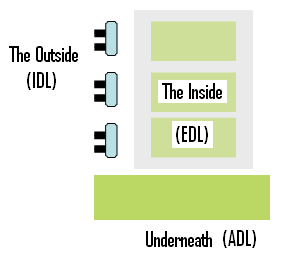1. You can look at the "interfaces" to identify the entry and exit points. Obviously, this is a big part of what web services are all about with WSDL as an "Interface Definition Language" or IDL.
2. You can look at the "engine" that provides the base infrastructure: "It's a database! It's a Rules Engine!", etc. Or more precisely, "It's an Oracle Version X database, with clustering". This is the "Architecture Definition Language" or ADL.
3. In addition, you can look at the mechanism that is used to "extend" the "engine" which provides the "interfaces". In an orchestration engine, the extension language might be "BPEL", in a presentation engine, the extension language might be "JSP". Once an EDL is identified, you can begin to look at the capabilities of the extension mechanisms (language features, libraries, etc.). Unfortunately the industry remains very immature in this area. However, I am confident that as the industry begins to understand the basics of a "language to create/describe languages" the art will quickly advance.
The software community is making progress in describing the systems we build. Our meta-descriptions of our building blocks and finished systems is a huge advancement toward the vision of the "software factory", "software IC", or which ever metaphor you prefer.

-------------------------------------------
INSIDE, OUTSIDE, UNDERNEATH & ALL TOGETHER!
Web services & SOA make people think about architecture from the "OUTSIDE" - that is, the external interfaces. The "EDL" allows you to evaluate it from the "INSIDE" - or how you build that which is exposed. The ADL facilitates "UNDERNEATH & ALL TOGETHER".
Although one of the primary benefits of SOA is to abstract the consumer from the architectural elements and extension mechanisms, this doesn’t mean that the architect that is creating the solution can avoid the issue. I firmly believe that the opposite is true. SOA architects must apply equal attention to these concerns as they do to their uniform interfaces, mediation strategies or WS-catalog taxonomy.
----
Note: I'm using the term EDL to describe the capabilities of a DSL or a general purpose programming language.
No comments:
Post a Comment